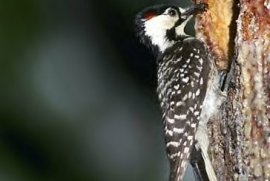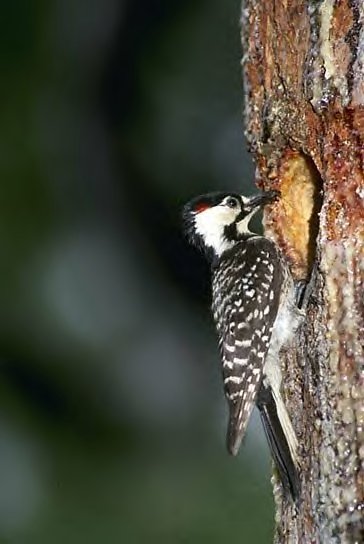Tree-clinging Birds
Description
8" (20 cm). Cap and nape black; large white cheek patch; back barred black and white; white below with black spots on sides and flanks. Male has small, hard-to-see red spot behind eye.
Endangered Status
The Red-cockaded Woodpecker is on the U.S. Endangered Species List. It is classified as endangered throughout its range in Alabama, Arkansas, Florida, Georgia, Kentucky, Louisiana, Mississippi, North Carolina, Oklahoma, South Carolina, Tennessee, Texas, and Virginia. This species needs old-growth pines for its habitat, and in the 1800s great stands of these trees were felled across the Southeast for lumber. The 20th century saw the development of renewable forestry techniques, and there are now many pinelands, but most of them grow in rows and lack the diversity of the former forests. The Red-cockaded Woodpecker requires trees that are a minimum of 80 to 120 years old, and it will be a long while before it is known whether it will recover.
Voice
A nuthatch-like yank-yank. Also a rattling scold note.
Habitat
Pine forests, especially yellow and longleaf pines.
Nesting
4 white eggs in a tree cavity, usually in a live tree with decayed heartwood.
Range
Historically, resident from southeastern Oklahoma and Maryland to Gulf Coast and central Florida.
Discussion
The Red-cockaded Woodpecker is one of the least known of the family. Although widespread in the Southeast, it is local and restricted to mature pine woods that contain trees whose heartwood has been softened by fungus, where the bird digs its nest cavity. Much less noisy and conspicuous than other woodpeckers and therefore seldom noticed, it travels in family groups of four to six. This woodpecker also has the peculiar trait of digging holes in trees adjacent to its nest, allowing pine gum or resin to ooze from the holes. Such signs of pitch may be evidence of its presence.


